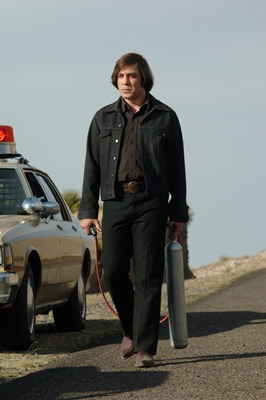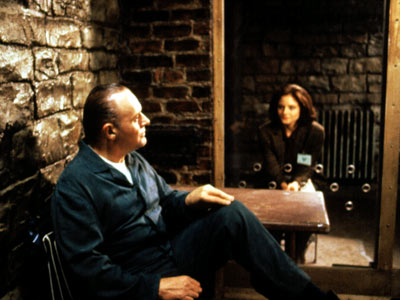If memory serves, this review provoked more hate mail than anything else I ever wrote for the Reader, very little of which engaged with my actual argument — a response I tend to correlate with this country’s unreasoning and irrepressible infatuation with and worship of serial killers as virtual religious icons (roughly akin to rock musicians who die of drug overdoses). But according to the Reader, it is also one of my most widely read Reader pieces. It ran in the November 8, 2007 issue, a little less than four months before I retired from the paper. — J.R.
No Country for Old Men | Written and Directed by Ethan and Joel Coen
The first thing we demand of a wall is that it shall stand up. If it stands up, it is a good wall, and the question of what purpose it serves is separable from that. And yet even the best wall in the world deserves to be pulled down if it surrounds a concentration camp. —George Orwell
I tend to get flustered when people ask me what I look for in movies, so I’m wary of theorizing too much about what other people want from them. Moviegoers generally seem to fall into one of two categories: those looking for experiences similar to ones they’ve already had and those looking for experiences that are new. Though I’m usually among the latter, I’m sometimes curious about why people return to certain pleasures, especially when I don’t share their taste.
One reason I tend to dislike movies about psycho killers is that I can’t respond to them with the devotion I feel is expected of me. I’m too distracted by the abundance of these characters on-screen when they rarely appear in real life, and by how popular they seem to become whenever we’re fighting a war. What is it about them that people find so exciting? Reviewing The Silence of the Lambs over 16 years ago, I was troubled by the way the thriller tapped into “irrational, mythical impulses that ultimately seem more theological than psychological,” and how critics who loved it seemed “better equipped to regurgitate the myth than to analyze it.”
I was especially bemused by the ready acceptance of Hannibal Lecter’s supernatural powers — his ability to convince a hostile prisoner in an adjoining cell to swallow his own tongue, for instance, or to know precisely when and where to reach Clarice, the movie’s heroine, on the phone. Anthony Hopkins’s Oscar-winning performance may be stark and commanding, but it wouldn’t have counted for beans if the audience hadn’t already been predisposed to accept this murderer as some sort of divine presence.
The waves of love that went out to Lecter, epitomized by the five top Oscars the movie received in 1992, were a mix of giggly fascination, twisted affection, and outright awe for his absolute lack of remorse. This was during the first gulf war, a time when we were grappling with our own feelings about killing masses of people on a daily basis. I suspect Lecter represented a savior of sorts, a saintlike holy psycho who made us feel less uneasy about wanton slaughter.
We may not feel the same kind of affection for the real psycho killers in our midst, but they do inspire similar fear, fascination, and mythologizing. Seung-Hui Cho was clearly crazy when he slaughtered 32 people at Virginia Tech last April, but he was also smart enough to know there was no question that if he sent a media kit off to the national press they’d use it. He might have had more power to get himself onto the cover of Newsweek than the editors would have had if they’d wanted to keep him off.
No Country for Old Men premiered at Cannes in May and was widely heralded as the festival’s most sensational entry. When I saw it for the first time at the Toronto film festival in September, the only movie that gave it any competition in the popularity contest was Lars and the Real Girl. Adapted from what is generally considered a minor Cormac McCarthy novel, No Country for Old Men is a very well-made genre exercise, but I can’t understand why it’s been accorded so much importance, unless it’s because it strokes some ideological impulse.
Much the same could be said of Lars and the Real Girl, a fantasy about communal life in a small town that the Reader’s J.R. Jones has aptly described as “Capraesque,” not to mention an evasive (and no less endearing) glossing over of disturbed sexuality (astutely unpacked in the New York Times by Manohla Dargis). As someone who grew up in a small town, I could certainly detect the falsity of the film’s premise — that everybody cares about everybody else, fuckups included — while at the same time admiring the skill of the actors in putting it across. As for its popularity, I can only guess that it must be rooted in the rosy, highly sentimentalized picture it offers of human nature.
The picture of human nature in No Country for Old Men is by contrast so bleak I wonder if it must provide for some a reassuring explanation for our defeatism and apathy in the face of atrocity. I admire the creativity and storytelling craft of the Coen brothers, but I can’t for the life of me figure out what use they think they’re putting that creativity and craft to. As I left the screening in Toronto, all I could think was, “America sure loves its mass murderers.” That conclusion was ratified by a line in the New York Film Festival’s blurb for the movie: “Wearing an unforgettably frightening pageboy and toting a cattle stun gun that’ll haunt your nightmares, Javier Bardem is Anton Chigurh, a psychopathic assassin of the highest order whose detachment is as shocking as the carnage photographed so gorgeously by DP Roger Deakins.”
I hasten to add there’s more to this grim, ambitious movie than a psychopathic assassin of the highest order whose carnage is gorgeously shot, though I seriously doubt it would be garnering so much enthusiasm without such perks. The intricate plot, set in rural Texas, involves three characters chasing after Llewelyn Moss (Josh Brolin), a lovable salt-of-the-earth type who stumbles upon $2 million and a mess of dead bodies in the wake of a blown drug deal in the desert. There’s the narrator, Ed Tom Bell (Tommy Lee Jones), a melancholy sheriff nearing retirement who investigates the murders. There’s Chigurh, an associate of the drug dealers who’s bent on recovering the money and totally unconcerned with how many innocent people he wipes out in the process. (Recalling some of the stylish moves that made Pulp Fiction such a hit, he idly tortures some of his victims with arcane mind games before shooting them.) And finally there’s Carson Wells (Woody Harrelson), a hired gun who offers some comic relief.
This grisly thriller qualifies in some ways as a remake of the Coens’ Fargo, with Bell and Moss jointly taking over the role of Frances McDormand’s pregnant police chief. Bell is the film’s moral center, the law in the midst of greed and senseless death. Moss, already marked by his relative indifference to the suffering of a dying Mexican in the opening sequence, becomes lovable only during his affectionate banter with his wife, Carla Jean (Kelly Macdonald). He’s the character we’re supposed to identify with, especially when he’s trying to match wits with the psycho killer.
In the past, the Coens have gotten a lot of mileage out of ridiculing most country folk for their stupidity while singling out a chosen few for admiration. But here, in deference to the source material, the condescension is toned down considerably. They show off their narrative expertise by converting some of the sheriff’s plaintive monologues into terse dialogue and even more in the way they juxtapose the separate movements of Moss and Chigurh, sketching out a suspenseful cat-and-mouse game with some of the primal impact of silent pictures.
What gives all of this a special kick is the way the killer commits murder without so much as a twitch, behavior we’re clearly expected to regard with a certain amount of awe. Chigurh isn’t an intellectual like Hannibal Lecter, and he lacks his cosmopolitan sense of humor, but he slays many more innocent people. And except for a stray line toward the end of the film, when he briefly alludes to his own birth being occasioned by blind chance, there isn’t a trace of psychological speculation about what makes him tick — only a passing remark by Carson Wells that he operates according to a twisted moral code of his own.
There’s a certain cleverness in the way the Coens, after piling on the corpses in the opening sequences, elide some of Chigurh’s actual murders toward the end, flattering the audience by suggesting they’re sophisticated enough to imagine the gorgeous carnage all by themselves. They even manage to acknowledge briefly the relevance of all this mayhem to the present occupation of Iraq (albeit somewhat anachronistically, as the action is set in 1980). At one point, Bell ruefully reflects to a colleague, “It’s just all-out war — there isn’t any other word for it,” and goes on to comment about the sad times we’re living in, when some people even resort to senseless torture, making particular allusion to Abu Ghraib by mentioning a torturer placing a dog collar around the neck of one of his victims.
But just because the Coens are hip enough to know the contemporary audience they’re addressing doesn’t mean they have anything to say we don’t already know, about Abu Ghraib or anything else. What I suspect they’re really offering us is a convenient cop-out: we can allow dog collars to be used even while we hypocritically shake our heads at the sadness of it all.









